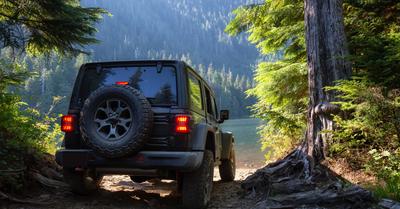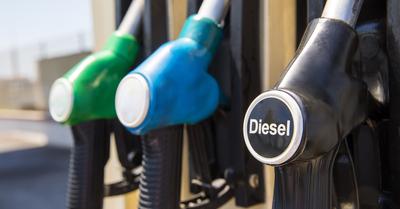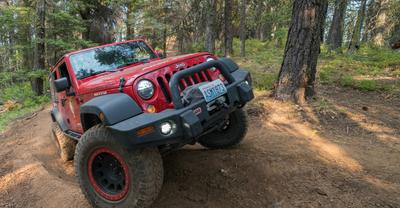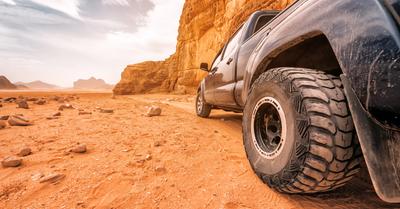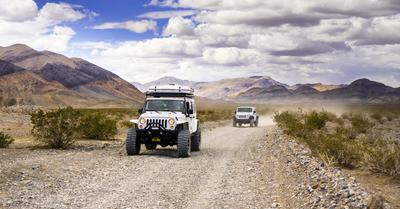Off-road tires are a common truck and SUV modification that can greatly improve performance. But do they affect gas mileage?
Off-road tires can decrease gas mileage due to their wide tread voids. Off-road tires have less contact with the road and work less efficiently, which causes an average MPG loss of around 3% to 5% on typical off-road vehicles.
In this article, we’ll go over all the ways that big off-road tires affect your fuel economy. We’ll cover tire weight, tread type, tire size, and some practical alternatives to off-road tires. Additionally, we’ll go over a few tips to improve your mileage with mud terrain and rock tires.
We sourced the information used in this article from reliable automotive guides and the online off-road community.
This article may contain affiliate links where we earn a commission from qualifying purchases.
Tire Size and Gas Mileage
Tire size can have a surprising effect on gas mileage. Vehicles are designed to run optimally with a specific tire size. Altering the tire size (and making them either larger or smaller) can have an effect on gas mileage. Famously, smaller tires cause the engine to rev higher and decrease gas mileage. But what about big tires?
In some cases, having larger tires can increase your gas mileage. The larger the tire, the fewer revolutions it takes to achieve the same speed and distance. At highway speeds, this is beneficial as it reduces sustained RPMs. However, larger tires require more force to accelerate and burn more fuel when speeding up.
Older trucks will probably notice an increase in gas mileage with larger tires, as long as the tread is about the same as the previous tires. Older trucks, namely those with three-speed transmissions (Ford C6, Chevy TH350, T18, SM465, Muncie rock crusher, etc.), will see the most dramatic mileage improvement.
This is especially true if you’re running a high rear-end ratio, IE 3:55, 3:70, or 4:11. These ratios spin the engine higher at highway speed, and an extra few inches of tire can drop the RPMs noticeably. Keep in mind that adding larger tires won’t make that big of a difference—but you may notice the tank staying a little fuller a little longer.
Are Off-Road Tires Bad for Mileage?
Off-road tires are a mixed bag when it comes to gas mileage. In theory, a larger tire should decrease RPMs and give you better highway mileage but worse city mileage. This can be demonstrated with some tires, though many truck owners complain about reduced mileage in all driving conditions.
Off-road tires with aggressive tread can be bad for gas mileage across the board. Most off-readers agree that swapping on mud or rock tires is a guaranteed fuel economy loss of around 3% on average, though some people report 5% to 10% lower mileage.
Why Do Off-Road Tires Reduce Fuel Economy?
Off-road tires with aggressive tread do, in fact, reduce fuel economy. The reason why becomes evident when you consider the road contact of a mud terrain or rock tire, and not just the outside diameter.
Take a look at the tread. What do you see? Most real off-road tires have large tread blocks and large tread voids, which are the gaps between the blocks. These voids are what differentiate off-road tires from highway tires, and they’re non-negotiable.
However, void space reduces tire efficiency and effectively shrinks the true diameter of the tire. If you were to squeeze the tire together and eliminate the void space, it might lose 10 or 15% of its diameter.
Road contact is what transfers energy from the drivetrain into forward motion. The less road contact, the less energy you transfer—and the more power and fuel you waste to go the same distance. This is one reason why race cars use slick tires, as they allow the maximum amount of power to translate into motion.
Which Off-Road Tires are Best for Fuel Economy?
Choosing the right off-road tire can have a big impact, especially if you spend most of your time on the highway. As a general rule, the more aggressive the tread, the more fuel you’ll burn. That’s why it’s best to choose a medium-level off-road tire if you’re concerned about gas mileage.
Large all-terrain tires are the best choice. These tires are big enough to give your truck that capable off-road look, but the tread voids are narrow enough to keep efficient road contact. Additionally, these tires perform well in all but the most extreme off-road conditions.
Does Tire Weight Affect Fuel Economy?
It’s no secret that off-road tires are heavy. Sometimes, they’re close to twice the weight of regular highway tires. It follows that, due to the increased weight, your truck will burn more fuel to push it around.
However, the weight of the tires probably doesn’t have a huge effect on fuel mileage. Anecdotal claims suggest that it does, but there’s not much evidence backing it up.
Alternatives to Off-Road Tires
There are a few alternatives to off-road tires to consider, especially if you’re just looking for bigger tires and a dirt truck look.
Big utility tires, such as all-seasons designed for larger trucks, are a good alternative. Picture a well-balanced 1970s 3/4 ton with nice big tires, and you’ll begin to get the picture. This setup works particularly well on classic trucks. It’s affordable and gives you increased ride comfort both on and off-road.
Standard all-season tires aren’t exactly off-road ready, but they’ll work just fine on dirt roads for the occasional trail drive. Remember, trucks used to do drives like that with bias-ply highway tires—and that was back before four-wheel-drive was even a factory option.
How to Improve Mileage with Off-Road Tires
If you’re set on improving your mileage without changing the tires, there are a few things you can do. Here’s how to improve your mileage with off-road tires.
Drive Carefully
First and foremost, avoid heavy acceleration and choose a lower highway speed. These two things alone can save a significant amount of fuel—and you won’t have to buy any parts.
Tune Up the Motor
You can also get a tune-up to reduce fuel usage, and you can do it yourself on an older truck. Replace the distributor cap, rotor, and ignition coil. Get a new set of plugs and plug wires, and give the carburetor a cleaning while you’re at it. Combine a tune-up with laid-back acceleration, and you can make notable improvements.
Change the Rear Gear Ratio
Additionally, you can swap out the rear gears and find a more suitable ratio. If you’re running 3:70s or 3:73s, consider dropping down to 3:55 or something similar. If you’re driving mostly on the highway, you can’t go wrong with 3:08 rear gears.
Set the Proper Tire Pressure
Tire pressure can have a huge effect on mileage. Tires without enough air pressure perform just as badly as tires with too much. If you air down on the trail, keep a tire inflator nearby to air up again before hitting the highway.


